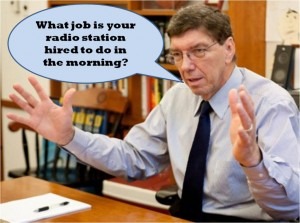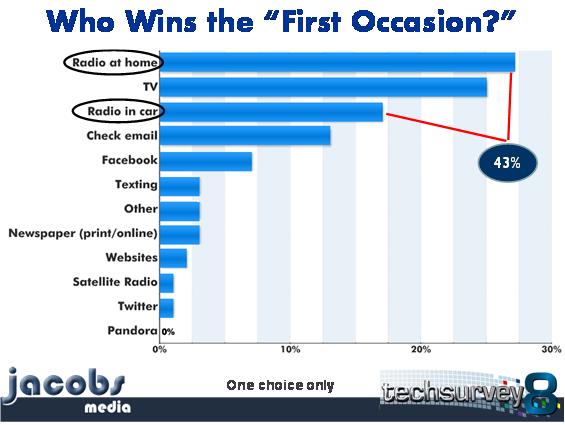I like to think of myself as a “Consumer Whisperer.” Over the course of any given year, my company is involved in umpteen research studies, from quantitative to qualitative, all designed to determine what it is real people are trying to tell us about our stations, our brands, and our medium.
So, we tried something different in Techsurvey8 this year, our national tech survey encompassing 170 radio stations across North America who produced 57,000+ responses.
We wanted to find out how people start their media day. With radio, TV, Facebook, email, or something else?
Now keep in mind these are very important radio listeners, the folks who signed up for station email databases. And it turns out the majority of them start their media day with something other than radio.
In fact, nearly six in ten begin their mornings by first turning on the TV, checking Facebook or email, texting, or other activities before they get around to turning on a radio at home or at work. Only 43% begin the day with radio at home or in the car.
Now since presenting Techsurvey8 a couple dozen times to broadcast companies and in a series of format webinars (Variety Hits is Monday, News/Talk is Tuesday of next week), a number of people have opined about whether this finding is necessarily bad.
After all, these consumers eventually get around to radio. And what can we do to stop them from going elsewhere to start their media day?
So here are my responses…
First, these are core radio listeners – the people in your database. A majority of them tell us they have “liked” your stations on Facebook. They are the 20% that we talk about in Pareto’s Principle – or the “80/20 Rule” – the ones who do the heavy lifting for your brand. When they start off with something other than radio, what does this tell us about the ways in which we’re satisfying consumer needs? Shouldn’t radio be doing better with these folks?
Second, Arbitron has taught us about the power and importance of “occasions.” For most stations, an extra one each week can be the difference in your station being a leader or a mid-pack player in the ratings. Imagine an extra occasion per day. So that “First Occasion” of the day is of paramount importance in setting the tone. And if listeners hear what’s coming up later in that hour or that day or tomorrow when they start their day with your stations, it could easily lead to more occasions.
Third, you have their attention first thing in the morning. Yes, they may be getting ready to start their busy routines, but unlike the occasions where radio is simply in the background, in mornings, they are listening for information or to have their mood elevated. Your message stands a good chance of being heard.
 Fourth, the loss of the “First Occasion” may speak to a greater deficit that is plaguing radio. As the thought leader Clayton Christensen might ask – especially about television – “What are consumers hiring TV to do in mornings?”
Fourth, the loss of the “First Occasion” may speak to a greater deficit that is plaguing radio. As the thought leader Clayton Christensen might ask – especially about television – “What are consumers hiring TV to do in mornings?”
Because TV is clearly delivering for lots of radio people. In a number of our format webinars (from Country to Sports/Talk to Classic Rock), TV is their first choice in the morning.
Somehow, those “Good Morning, Des Moines” local shows, along with Today, Good Morning, America, Fox & Friends, HLN with Robin Meade, and Morning Joe are effectively stealing audience from morning drive radio. Had we asked this question just a dozen years ago, how do you expect these numbers would have differed?
Radio could do itself a favor by studying this issue, and then developing strategies and tactics to attract audiences back to win those “First Occasions.”
And if you tell me that no one can stop consumers from checking Facebook or scanning email first thing in the morning, I’d tell you this:
If that’s what your audience is doing to start their days, then doesn’t it make sense for you to be sure there’s a great post or an essential email waiting for them at 6 in the morning? Even if they start somewhere else, knowing that destination can lead to effective tactics to regain their attention and their media usage.
Knowledge is power, and Techsurvey8 provides more than just a series of pretty pie charts, graphs, and word clouds.
Turning data into strategies is the true “secret sauce” of research. I’m hearing core consumers whispering very loudly to me.
What is the data saying to you?
- What To Do If Your Radio Station Goes Through A Midlife Crisis - April 25, 2025
- A 2020 Lesson?It Could All Be Gone In A Flash - April 24, 2025
- How AI Can Give Radio Personalities More…PERSONALITY - April 23, 2025





I think the fact that people are starting their morning checking email or facebook is great for Radio. Internet Radio audiences listen to the medium while emailing and visiting social networking sites.
Nearly 40% listening on line recommend or share their favorite stations and 35% link an Internet Radio profile to a social network. These facts all come from our latest White Paper; TargetSpot Digital Audio Benchmark and Trend Study 2012.
This will not drive your broadcast ratings but its a great opportunity to capture listeners on a device they are already starting their day.
By the way, if you would like to see the latest research, just go to targetspot.com, click on Insight and then click on Research.
I share your enthusiasm, Andrew, and included some of those tactical options in my post. You’re seeing some of the same things we saw in Techsurvey8. Sharing, recommendaition, and social channels present huge opporutnities for strong radio brands. We should stop questioning the ROI of these tools, and start figuring out how to more effectively use them. Appreciate you taking the time to comment.